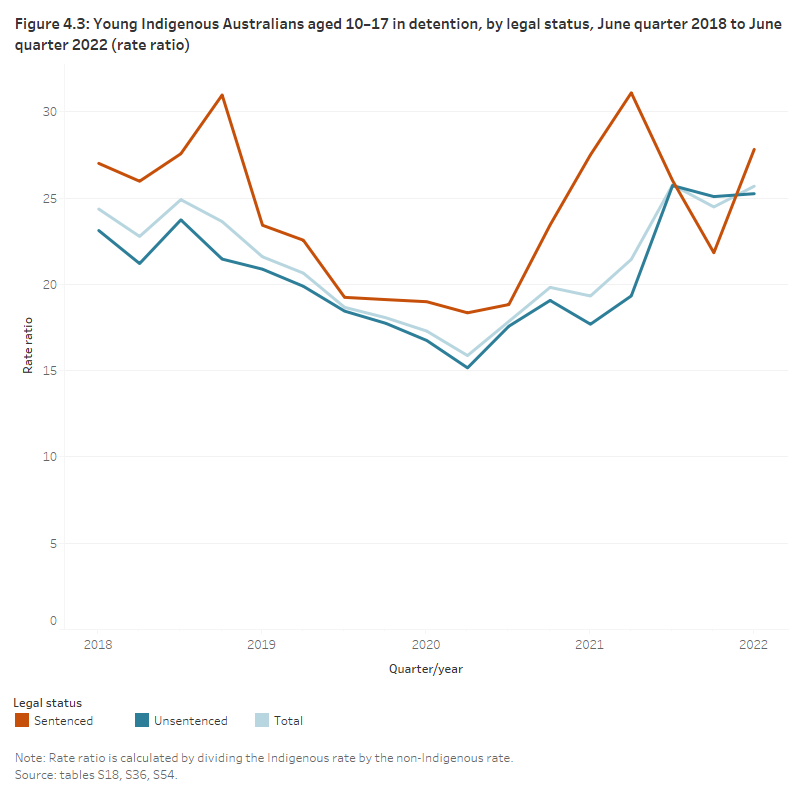Rates
Nationally, on an average night in the June quarter 2022, 29 per 10,000 young Indigenous Australians aged 10–17 were in detention, and 1.1 per 10,000 young non-Indigenous Australians aged 10–17 were in detention.
Indigenous over-representation in youth detention can be expressed as a rate ratio, which compares the rate of young Indigenous Australians to that of young non-Indigenous Australians (see ‘Technical Notes’ for more details).
This means that young Indigenous Australians aged 10–17 were 26 times as likely as young non‑Indigenous Australians to be in detention on an average night in the June quarter 2022 (Table S10).
The rate of young Indigenous Australians aged 10–17 in detention on an average night decreased over the 4‑year period, down from 34 per 10,000 young Indigenous Australians aged 10–17 in the June quarter 2018. The rate was higher than the June quarter 2021 (24 per 10,000). The rate was at its lowest during the September quarter 2020 (19 per 10,000) (Table S18).
This means that over the 4-year period, the level of Indigenous over‑representation in detention fluctuated, ranging from 16 times the non-Indigenous rate in the September quarter 2020 to 26 times in the December and June quarters 2022.
Age group
Nationally, on an average night in the June quarter 2022, 4.5 per 10,000 young Indigenous Australians aged 10–13 were in detention and 0.1 per 10,000 young non-Indigenous Australians aged 10–13 were in detention.
This means that young Indigenous Australians aged 10–13 were 51 times as likely as young non‑Indigenous Australians to be in detention on an average night in the June quarter 2022. This is down from 72 times as likely in the June quarter 2018, where 6.0 per 10,000 young Indigenous Australians were in detention on an average night (Table S16).
For those aged 14–17, there were 55 per 10,000 young Indigenous Australians in detention in the June quarter 2022 and 2.3 per 10,000 young non-Indigenous Australians in detention. This means that young Indigenous Australians aged 14–17 were 24 times as likely as young non‑Indigenous Australians to be in detention on an average night in the June quarter 2022.
Legal status
From the June quarter 2018 to the June quarter 2022, the rate of young Indigenous Australians aged 10–17 in sentenced detention dropped from 12.2 per 10,000 to 5.4 per 10,000. The rate was at its lowest in the March quarter 2022 at 4.7 per 10,000. The rate of young non-Indigenous Australians aged 10–17 in sentenced detention gradually declined from 0.5 per 10,000 in the June quarter 2018 to 0.2 per 10,000 in the June quarter 2022 (Table S54).
The rate of young Indigenous Australians aged 10–17 in unsentenced detention fluctuated over the period showing no apparent trend but was at its highest in the June quarter 2022 at 24 per 10,000. The rate was at its lowest in the September quarter 2020 at 14.4 per 10,000. The rate of young non‑Indigenous Australians aged 10–17 in unsentenced detention was relatively stable over time ranging from 0.8 per 10,000 to 1.1 per 10,000 (Table S36).
The Indigenous rate ratios in sentenced detention and unsentenced detention were relatively similar for all quarters. The exception to this was the March quarter 2019 and March to September quarters 2021, where there was a sharp increase in the Indigenous rate ratio for sentenced detention (Figure 4.3).
Figure 4.3: Young Indigenous Australians aged 10–17 in detention, by legal status, June quarter 2018 to June quarter 2022 (rate ratio)
This line graph shows the level of Indigenous over-representation as a rate ratio, which compares the rate of young Indigenous Australians to that of young non-Indigenous Australians. The 3 lines show the rate ratio for sentenced detention, unsentenced detention, and the total of both. Over the 4-year period, the level of Indigenous over‑representation in detention fluctuated, at a rate 16–26 times the non-Indigenous rate.



